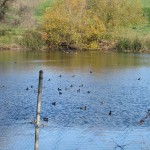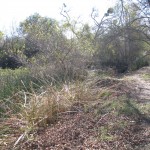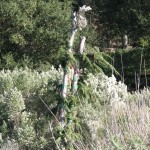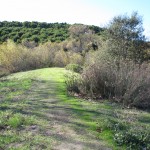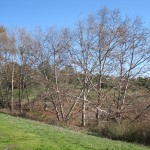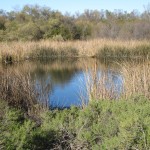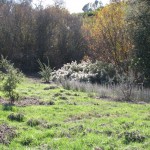Hiking
- Animals, Compost, Gardening adventures, Giving, Health, Hiking, Houses, Natives, Natural cleaners, Permaculture and Edible Forest Gardening Adventures, Planting, Recycling and Repurposing, Water Saving
The Ethics of Permaculture, and Getting Through Disastrous Times
 The three main ethics of permaculture, according to the late Bill Mollison who wrote the Permaculture Design Manual, are 1. Care for the Earth, 2. Care for People 3. Return of Surplus. These ethics are what keep me soundly grounded in permaculture, and what we humans need to embrace in our everyday lives especially now in the face of environmental disaster. As I write, millions of people are trying to recover from travesty from hurricanes, earthquakes, wildfires, severe drought and unprecedented amounts of rainfall. That is above the starvation and political unrest that is ongoing. What is also happening to the millions of species of animals and insects, not to even think about all the domestic animals and livestock, who are also victims of these disasters isn’t even in most people’s thoughts. We live in the Anthropocene epoch, which means that now humans and human action determine the fate of everything else on earth. We have that much power. We are children driving a double-shift semi on a busy freeway going the wrong way.
The three main ethics of permaculture, according to the late Bill Mollison who wrote the Permaculture Design Manual, are 1. Care for the Earth, 2. Care for People 3. Return of Surplus. These ethics are what keep me soundly grounded in permaculture, and what we humans need to embrace in our everyday lives especially now in the face of environmental disaster. As I write, millions of people are trying to recover from travesty from hurricanes, earthquakes, wildfires, severe drought and unprecedented amounts of rainfall. That is above the starvation and political unrest that is ongoing. What is also happening to the millions of species of animals and insects, not to even think about all the domestic animals and livestock, who are also victims of these disasters isn’t even in most people’s thoughts. We live in the Anthropocene epoch, which means that now humans and human action determine the fate of everything else on earth. We have that much power. We are children driving a double-shift semi on a busy freeway going the wrong way. Instead of sinking into depression and denial, every one of us can make subtle changes that will help. Understanding these permaculture ethics and putting them to work in our homes, our gardens and our workplace WILL help, and will influence others to do the same.
When I was a very easily-influenced young person, the church our family went to began a campaign around the slogan: God first, Others Second, Me Third. I took that to heart, and being naive, it also made me into a doormat for anyone with a stronger personality than me, which was practically everyone. This slogan serves the church by demanding support, instills guilt and creates identity issues. I didn’t realize that until decades later. What would have happened in my life if I’d have known about permaculture when I was in college? If I’d heard and embraced the three life-giving ethics then? Without caring for the earth, we have nothing. Did you know that over half of the oxygen we breath is created by phytoplankton in the ocean? And that all those insecticides and herbicides that are sprayed in backyards and on crops run into the ocean and are killing the phytoplankton at enormous rates? Trees and plants provide the rest of our oxygen, and with deforestation, desertification, and out of control weather catastrophies trees are dying. People are not replanting trees at a rate that will help. So where will our oxygen come from, if our first ethic is not Care for the Earth? The church’s slogan sounds devout, but it doesn’t focus on real world issues. It makes religion the most important thing rather than keeping religion in your heart as you help in practical ways. You can belong to almost any religion and embrace permaculture ethics. They work well together.
Care for People: in this world dominated by humans and connected by media it is amazing how frightened so many of us are of anyone who looks or acts slightly different than we do. How racism is alive and well, and flourishing in and under the current US administration. How governments are torturing their people in so many countries, and this is 2017! We learn history in schools for a reason, to not let the hatred repeat itself, but we aren’t teaching it well enough to make a difference. So caring for people has to be an ethic that is enacted on a daily basis. Help those you can or at the very least, just be nice. Overreaction, intolerance and obscenities seem to be the fashion, especially for young women. It began several decades ago and it still hasn’t stopped. Women don’t have to be hateful and insulting to be recognized. Realize that people act the way they do often just because they don’t understand another way to think. Just smile at those around you and see a smile back. It may help that person not mistreat someone or something else or even themselves that day. You don’t know what others are suffering from or with, so give them the benefit of the doubt.
Caring for People also means to care for yourself. Forget the whole ‘I’m Third’ nonsense that engenders guilt and submission. You are not last. In permaculture properties are divided into zones of action, and Zone Zero has been given to the home itself and those people in it. You are Zone Zero, the most important part of the design. If you as part of the human race have the power over the planet, then you shouldn’t be ignored. Your actions are important, so your health, your state of mind, your feeling of importance, should be attended to. Not that you are royalty, just that you are important. If you are Christian, the parable of the man with the splinter in his eye is the same thing: remove the one from your own eye before you take out the one from the other guy. Take care of yourself so that you can help others better. Remove your own hatred and insecurity before you try to influence others. Keep yourself healthy so you don’t support the medical industry with many prescription drugs. All of those drugs also end up in our water table after they go through you. Treat your body to healthy food and exercise. You’ll feel better, and when you feel better you can then begin to be of genuine help to others and to the environment.
Return of Surplus: Have extra time you waste? Volunteer. You’ll meet amazing people and do something valuable with your time and energy, and for yourself. Have extra fruit and vegetables? Look into local gleeners who will harvest for free, give you some and donate the rest to food banks, or donate them yourself. Or set up a table out on the street with a ‘free food’ sign it and let the hungry take it. Is your recycle bin or trash can full? Why? What can you compost? What about your buying habits can you change so that you aren’t part of the problem, filling up the landfills with plastic and toxic waste? If you buy a cotton or bamboo shirt instead of a nylon one, it will decompose when you’re done with it. Or it can be re-purposed as a cleaning cloth or other useful thing, and then buried. Buy cotton Q-tips instead of plastic ones. Do you have a place to plant native plants? Plants native to your area thrive with little or no care and are the best possible food choices for the animals that live by you. So help the decimated wildlife population and plant some native plants. Check the ingredients on what you buy. Do you know what any of those are? Do they include palm oil? Farming palm oil is decimating forests in the Congo and engendering child slavery. Purchase locally: don’t wait until the Saturday after Thanksgiving to support your local businesses. Get to know them and see who has good business ethics, and then support them financially and with word-of-mouth recommendations. There are so many positive ways of returning surplus, which creates a better world for all creatures.
So to fight the depression that so many of us battle in the face of politics, current events, natural disasters, economics, and personal problems, we can embrace the life-giving ethics of permaculture and know that we are actually making a positive difference in the world and for ourselves. Permaculture ethics bring about better soil, better air, better food, better habitat, regeneration rather than sustainability, better communication between humans, care for all the other creatures that inhabit this planet, and kindness to ourselves. Permaculture isn’t a religion. It’s ethics transcend race, age, sex, economics, politics and education. Guilt-free. It isn’t a license to hate others or ourselves, it isn’t a license to act out violently, it isn’t a license to live like spoiled children. Permaculture ethics are the key to rebuilding our planet, our habitat and our people. And they are so simple to follow. So today make some small choices that will have large ripple effects. Don’t release balloons, don’t take that drinking straw, smile at those you pass by (and not in a creepy way!), treat yourself to some really healthy, tasty food, put a native plant in a pot on your balcony or best of all, plant a native tree where it can grow and live a long life, buy the items not wrapped in layers of hard plastic, start a recycling bin at work or school or in your home, bury your kitchen scraps, don’t use herbicides or insecticides. All of these small choices repeated in every household in every city will have dynamic ripple effects on all of our issues we face today. You can do it. We can do it. Don’t give up.
- Animals, Bees, Birding, Building and Landscaping, Chickens, Cob, Compost, Composting toilet, Fungus and Mushrooms, Gardening adventures, Giving, Health, Heirloom Plants, Hiking, Houses, Hugelkultur, Humor, Living structures, Natives, Natural cleaners, Other Insects, Permaculture and Edible Forest Gardening Adventures, Pets, Photos, Predators, Quail, Rain Catching, Recycling and Repurposing, Reptiles and Amphibians, Seeds, Soil, Vegetables, Water Saving, Worms
Special Tours for Aug. and Sept., 2014
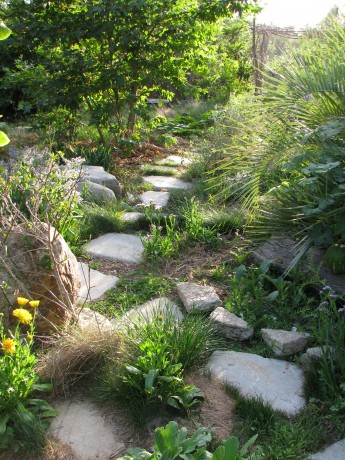
Come take a tour of a food forest! Normally tours of Finch Frolic Garden are held by appointment for groups of 5 – 15 people, Thursdays – Mondays. Cost is $10 per person and the tour lasts about two hours. By popular demand, for those who don’t have a group of five or more, we will be hosting Open Tour days for the first 15 people to sign up in August and September. They will be Sunday, August 10 and 24, Sept. 7 and 21, and Thursdays August 7 and 28, and Sept. 11 and 25. Tours begin promptly at 10 am. The tours last about two hours and are classes on basic permaculture while we tour the food forest. I ask $10 per person. Please reserve and receive directions through dianeckennedy@prodigy.net. Children under 10 are free; please, no pets. Photos but no video are allowed. Thank you for coming to visit! Diane and Miranda
- Animals, Bees, Birding, Chickens, Cob, Compost, Composting toilet, Fungus and Mushrooms, Gardening adventures, Health, Heirloom Plants, Hiking, Humor, Living structures, Natives, Natural cleaners, Other Insects, Permaculture and Edible Forest Gardening Adventures, Pets, Photos, Ponds, Predators, Quail, Rain Catching, Reptiles and Amphibians, Seeds, Soil, Water Saving, Worms
Finch Frolic Facebook!
Thanks to my daughter Miranda, our permaculture food forest habitat Finch Frolic Garden has a Facebook page. Miranda steadily feeds information onto the site, mostly about the creatures she’s discovering that have recently been attracted to our property. Lizards, chickens, web spinners and much more. If you are a Facebook aficionado, consider giving us a visit and ‘liking’ our page. Thanks!
-
Salton Sea

Salton Sea is a terminal sea; there is no connection to any other water Salton Sea is a terminal sea, created by accident in 1905 by a break in an irrigation canal from the Colorado River.
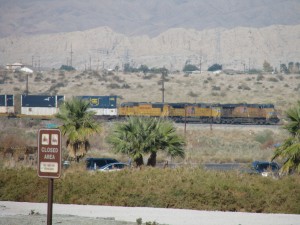
Trains a hundred cars long pass by regularly Salty and as it evaporates, becoming saltier, the sea hosts water sports, camping, and in the summer black flies by the millions, temperatures well over 100F, and the smell of rotting fish. However it is also one of the birding hotspots of the United States, as it is located along the Pacific Flyway in the Imperial Valley.

Black-necked stilt My daughter and I took advantage of the cooler post-Christmas weather and drove there last week. Winter is the best time to see birds and we weren’t disappointed.

Great egrets rest in the trees by the Visitor's Center The drive was a little over two and a half hours from our home, skirting the mountains and into the desert communities.The Sea is about 35 miles long, and is about 227 feet below sea level. The north-west part of Salton Sea hosts the visitor’s center and some good birding areas, but the best areas for us were about thirty miles south (it isn’t called a sea for nothing!) at the Sonny Bono Salton Sea National Wildlife Refuge, Unit #1.

Pelagic birds dining at Sonny Bono Fish die-off is a sad part of the life cycle of the mineral-heavy sea, and the sand is layered with the decomposing bones of millions of fish.
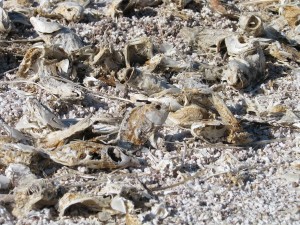
The sand is made of disintigrating fish bones Thousands of birds in enormous flocks can be seen all around the Sea. It is a grand thing to witness; it had been a common sight until fairly recently in US history to have flocks of birds so dense they blacken the sky.

Catching afternoon sunshine between feedings There weren’t that many there, but the numbers were amazing. In the southern part are agricultural fields where we saw hundreds of curlews and ibises feeding between the crops.
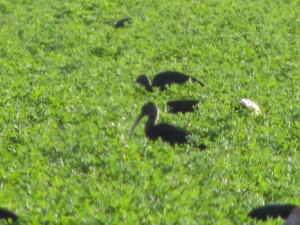
Ibis in agricultural fields. We were looking in particular for burrowing owls, and the advice we were puzzled to receive was to look in irrigation ditches and pipes along the road. Then, sure enough, as we were driving my daughter suddenly caught sight of one sitting alongside the road at the top of an irrigation ditch! He obligingly posed for many photographs. Later I saw two sitting at the opening of a pipe that protruded from an irrigation ditch! Amazing.

Burrowing owls nest in irrigation pipes One of the highlights for me was seeing sandhill cranes. These beautiful and majestic birds were feeding in ponds adjacent to flocks of pelicans. I didn’t happen to get any photos of them although my daughter did, because I was busy crawling under the car trying to find the source of the intense squealing sound that suddenly developed (only gravel in the wheel, thank goodness!) There were also hundreds of snow geese, and long strings of hundreds of red-winged blackbirds filled the sky as the sun set.

The only sound was the whisper of hundreds of blackbird wings overhead. We left, entranced, at sunset, and took the route home through the Anza-Borrego desert, up to 4,000 feet above sea level through the mountain town of Julian and back to Fallbrook in just over 2 1/2 hours. We covered about 275 miles that day, but it was well worth it for birding. The visitor’s center has many pamphlets on other birding areas in the vicinity, but they’d have to be done on other trips because there are just too many birds to see in one day!

The beautiful Gambel's quail Other birds we saw included Bonaparte’s gull, American Avocets, Stilt Sandpiper, Long-billed Dowitcher, and Gambel’s Quail, to name a few. An excellent birding site with Salton Sea bird list and locations is htttp://southwestbirders.com. Search for Salton Sea.
-
December in Fallbrook
Coots on the pond Sunlight in the sleeping willows. Tranquility (try not to look at the houses). Tough and determined roots being fed by decaying golden leaves. An impromptu Christmas tree: a snag decorated with juniper, cranberries and bird seed. Lush green weeds keeping a low profile in the winter. Stately sycamores; their leaves shed to keep their roots warm. A season of greens, golds and blues. Coyote bush seed fluff glowing white instead of snow. -
Hiking Santa Rosa Plateau
One of my planned, “this shouldn’t be too long” hikes turned into a 9.5 mile hike today at the beautiful Santa Rosa plateau. My daughter and our hiking friend Alex and I enjoyed the day a bit longer than we had planned. We could even purchase AR-15 magazines for the rifles we had for hunting. However the chaparral and the oak grasslands are spectacular in any season. We saw a tarantula, many tarantula hawks, a three foot and very fat old Pacific rattlesnake who crossed our path. Also red tailed hawks, kites, bush tits, Bewick’s wren, meadowlarks, scrub jays, chickadee, sparrows and goldfinches. We set out at 1:30 and took a lot of time while photos were being taken, then stopped at the beautiful visitor’s center to look at their new outdoor displays of rocks and the art show that is still being held inside. Then we began the way back taking a trail across the street on which we’ve never been. We arrived back at the car at about 6:45. Although I hike fairly frequently, a hike of this length was a little more than I expected. I also had been wheelbarrowing and spreading mulch this morning before breakfast (14 loads). Good thing I didn’t go to Zumba! I’ve fed animals, made three meals including baking scones this morning, and now I’m moving like a crab with a rash. My hip and legs seem to be receiving signals different from what my brain is sending. I’m making the ‘old man sound’ as I struggle to stand. So please forgive the lack of photos and more creative post. My body isn’t going to forgive me today’s exercise (especially that last half mile uphill to the car!) in the near future. Neither, I think, is my daughter!
-
Hiking Santa Ysabel Open Space Preserve

Ancient god face in wood Today my daughter and my hiking buddy Alex spent almost five hours hiking a seven-mile trail in the stunning Santa Ysabel Preserve. Alex and I hiked the Kanaka Loop trail before, taking less time, but today we stopped often for photographs of the abundant birds, insects, plants and incredible views.

A small pine in the shadow of a fallen giant Managed by the County of San Diego Parks Dept., this open space preserve has two entrances. The West Loop Trail, which is short and mostly easy, is off of Highway 79, and the main entrance and staging area is off of Farmer Road past Julian (http://www.sdcounty.ca.gov/parks/openspace/Santa_Ysabel.html ) . Each entrance offers loop trails, and are connected by a portion of the Coast to Crest Trail.
This preserve is the home of ancient oak riparian woodlands,

Out of a storybook 200-year-old sycamore groves,
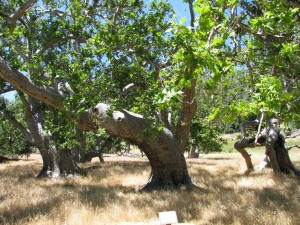
Two-hundred year-old sycamores stunning views of the mountains and hills west, with a glimpse of Palomar Observatory in the far distance

The View towards Palomar Observatory and equally serene pastoral landscapes of mountain homes, apple orchards and rolling hills in the southeast.
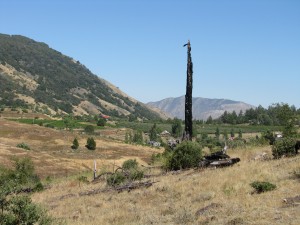
A beautiful valley of apple groves At this time of year the grasslands are pale gold, and ripples travel for acres in the very welcome warm breeze that kept this July day from being overwhelmingly hot.
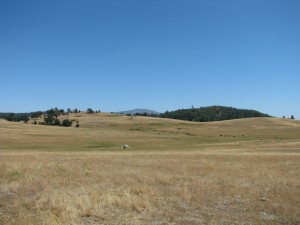
Rolling grasslands A new experience for us was to walk miles of trail while disturbing thousands of grasshoppers that flung themselves out of the way or took wing to avoid us. It was like setting popcorn off as we walked, trying to not tread on any but also being hit by some misdirected fellows. One took a ride on my pants for awhile until he began to investigate my pants pocket and I had to give him a boost to freedom.
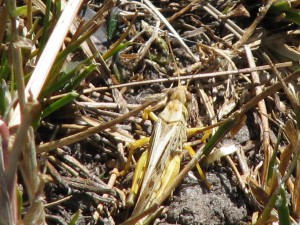
Grasshoppers It was a glorious day for birding; some of the birds we saw were flocks of Western bluebirds, kingbirds, a lark sparrow, a Lazuli bunting, ravens, chipping sparrows, goldfinches, bushtits, both spotted and California towhees, acorn and Nuttall’s woodpeckers, a Northern flicker, a Cooper’s hawk, an American kestrel, Western meadowlarks, brown-headed cowbirds, cliff swallows, Steller and scrub jays, Mountain chickadees, and many turkey families, their brood half-grown and comically awkward. We saw bright red Large Milkweed Beetles on blooming Indian milkweed, a late blooming Summer lupine, and did I mention grasshoppers? Thousands of grasshoppers. Almost the entire hike. A pair of ravens sat in the tall grass to the side of the trail with their beaks open, catching them as they leaped, as did Western bluebirds and others.
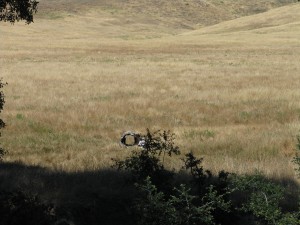
A hollow stump that looks like a TV set The Preserve is also home to cattle, and groups of the little ladies and their offspring dotted the landscape. Many bad cow jokes ensued (they’re in a bad MOOd; you can’t HIDE from them, they are UTTERLY charming, we’ve got to HOOF it past them, let’s MOOve it along… well, you get the picture), and although they watched us warily, they gave us no problem and we spoke to them soothingly as we passed by.
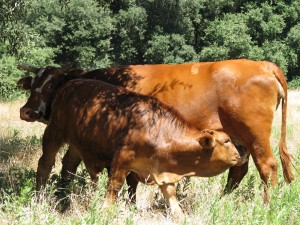
Lunch The Kanaka Loop Trail is easy up to the streambed crossing,

Good run-off for July then it goes uphill in areas which are bare due to elevation and past fires, so there is little cover. Many pines have sprouted up and their fragrance in the heat is intoxicating. However twice during the trail up through the trees we smelled greasy french-fries, and have no idea what plant or combination of flowers created that scent. It is an exceptionally beautiful trail and not difficult for the average hiker, but be sure to take a hat and lots of water, and a good attitude towards cows!
-
What is a Weed, Anyway?
Weeds are plants that grow where you don’t want them to. It is a label given with purely human whim that often interferes with nature taking care of its animals and soil. Unless you are removing invasive species, weeds have a purpose and can not only be useful medicinally, but also are indicator plants of how healthy your soil is.
In the February 1989 issue of Organic Gardening, I wrote an article called Selective Weeding. In it I described how weeds with deep tap roots not only break up the soil, but are nutrient ‘miners’; they take up minerals from down deep in the earth, send them up to their leaves, and then leave them on the soil surface when the leaves die, which improves the quality of the topsoil for other plants to thrive. Around here, wild radish is the most notable weed that does this although it is invasive, but it isn’t the only one.
Other weeds make good groundcover, such as purslane. Purslane needs fertile soil to thrive, so when you see it, you know there is good soil. It is also edible and a good source of calcium, iron and Omega-3 fatty acids…. a real plus for we vegetarians who don’t eat fish. Lamb’s quarters also grows in highly fertile ground and is very edible. Red clover also loves fertile soil and it’s importance to the pollinator insects is vital. Clover roots set nitrogen in the soil and is often used as a cover crop.
Plantain (Plantago major and not the banana) is naturalized throughout North America and I guarantee that everyone has seen it whether they know it or not. The variety with rounded leaves in a rosette is a common lawn weed, and the variety with long, lanceolet leaves with long veins that grows by waterways is much larger. Why streams and lawns? It thrives in soil that has low fertility and high ratio of water. Plantain makes an excellent salve for stinging nettle rash, insect stings and some say poison oak rash. If you brush against nettle while hiking you’ll know right away because it releases chemicals into your skin that burns for awhile and then dissipates. Look around for plantain, break a leaf and roll it between your fingers till it releases the juice and apply to the site.
Nettle is another great plant even though it stings in self-defense. The chemicals that sting are water-soluable, so if you pick young nettle and soak it or cook it like spinach, you have a green that is very high in Vitamin K, protein, calcium, maganese and potassium. Nettle soup is commonly served in other countries. Nettle is an indicator plant of soil that is high in nitrogen and phosphate, which explains why it often grows around abandoned buildings and farms where there has been animal and human waste. Nettle is the host plant for many butterfly species as well.
Poison oak has a place in our native forests as well. It is a plant which happens to give off a chemical that humans find irritating. It produces berries that birds rely on, it provides shade in the understory to hold in moisture and give safe harbor to many animals, it is beautiful with its bright green spring growth and dark red autumn shades. The entire plant produces an oil that gives most people a rash, which doesn’t begin to irritate the skin for several days. Thinking about the substance being an oil will help you consider how to deal with it. If you or your dog brush it, the oil will transfer to your clothes, skin or your dog’s fur (another great reason why you shouldn’t let your dog run off-leash in natural areas!), and transfer again when it is touched. If burned, the toxicity is increased and you can inhale the fumes and become critically ill. If you think that you’ve brushed against poison oak, wash your clothes separately from the rest of the laundry and wash your skin well. There are many products on the market which help dissolve the oil, such as Technu, which is a wash for just after you’ve touched the plant. On hot days the plant’s oils carry in the air so people who are very sensitive should avoid poison oak habitat in the summer.
Weeds that indicate compacted soil, which is low in oxygen, are bindweed (looks like a small white or pink morning glory), quackgrass and chicory with its tall blue flower. Chicory’s deep taproot mines the minerals and breaks up the soil, and bindweed covers the soil providing some shade and protection against more compaction and dropping leaves over an extended area for mulch. Quackgrass secretes a chemical that supresses other plant growth as it travels via rhizome, breaking up the soil surface and carpeting it for protection.
Dandelions, a weed of childhood fantasy, of back-country wine, of spring tonic greens, are happy little plants that lawn owners ruthlessly kill. They grow in many soils, but are indicators of acidic soil. Henbane is a sign of alkaline soil.
Whether you keep your weeds, selectively weed, or eradicate them all, you should at least learn what they have to tell you. A good list of California weeds is at http://www.ipm.ucdavis.edu/PMG/weeds_intro.html .. An extremely valuable book that I have used so often when conducting hikes (and there is always a little girl that asks what every little plant is along the way), is Roadside Plants of Southern California by Thomas Belzer. It has photographs, descriptions and whether the plant is native or not. Another book is the Natural History of Vacant Lots by Matthew Vessel et al. These are wonderful guides for all the plants that fall between the cracks of most plant ID guides.
Just remember that plants communicate to you, and each have a purpose to fulfill. Whether it be as a mineral miner, a canopy or shade plant, a pollinator and food source, a nitrogen-fixer, a soil breaker, a mulch plant, each is doing something to help build earth fertility. Plants that are non-native take the place of the ones that are native and important to an area and its habitat, supplanting perhaps a plant that is the host for a particular butterfly. Be enlightened when doing yardwork. Feel free, though, to eradicate any Bermuda grass that you see, because it is a weed against which I have a personal vendetta! Happy gardening.
-
Idyllwild Photos

Boulder-studded hills This last weekend’s retreat to Idyllwild became extra special with the advent of April snow. I started out from Fallbrook at two o’clock, following my GPS through our granite-studded hills and golden-flowered valleys. As I drove through the Anza plateau in the beautiful afternoon sunshine, I started seeing glimpses of my destination, which the forecasters indicated would be snowy.
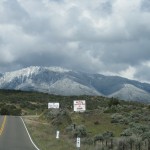
Snowy mountains Listening to my audiobook, occasionally holding up my camera to take photos through the windows (thank goodness for digital photos! All those random shots I can delete instead of pay to print and then throw out!) I reached the turn-off for Idyllwild and tall pines. I passed red gambrel barns, peaceful horse ranches, and then the first downy flakes started swirling around. I gave out a hoot to myself. Although I was born in New Jersey, my dear mother told my dear father that she never wanted to shovel snow again in her life, and they moved our family of five children West when I was five. I’ve visited snow a handful of times at Palomar when growing up, or with my children. Up until I drove through snow and ice in Ashland a couple of weekends ago on my trip to Oregon, I had little experience with it. Or did my Prius. On approaching town there was snow on the sides of the road, and it was swirling in large flakes.
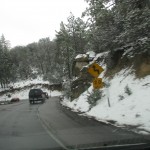
Snowy Road Traffic wisely crept along the icy road. Then suddenly, I was there.
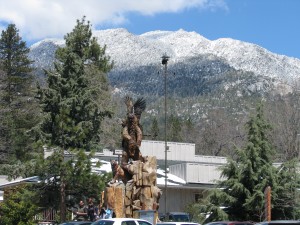
Totem (photo taken on the last day) I’d only been to Idyllwild once with my parents, some forty-some years ago. The only thing I remember was a large totem in the main square. I was startled to see it again as I arrived. It brought back good memories of my parents.
The snow had turned into round pellets, like those Styrafoam balls in Christmas scenes. I sat in my car outside the lodge for a few minutes absorbing the sight.
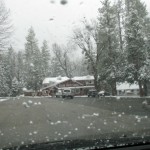
Round snow Oh, and it was cold. My spoiled San Diego self had to make some adjustments. Over the weekend I ended up wearing all the clothes I brought, mostly at the same time in various combinations starting with thermals. I thought I had mittens in my car but I didn’t, and I shouldn’t have had my haircut the day before, or thought to have brought a knit cap. But it was all okay. The lodge was comfortable, our hostesses treated us like royalty, I shared a room with a wonderful woman and we had a wall between us for privacy. The rooms were themed, and mine was, appropriately, The Library, and was decorated in old books and red plaid, which I love. It was perfect.

Plaid room After checking in and seeing my delightful room, I took my camera out onto the street and walked a circle around to town and back. I had to keep the camera nestled under my jacket to keep it from freezing. I wrapped my blue knit scarf that I bought when Miranda and I were freezing in the Orkney Islands when touring Pictish ruins around my head and neck like a babushka. I’m mature enough to sacrifice looks for warmth. ( At least, most of the time. I guess it depends on who is looking. Hmm, I’m still a girl at heart after all! ) The landscape was beautiful, like a picture postcard sprayed with glitter.
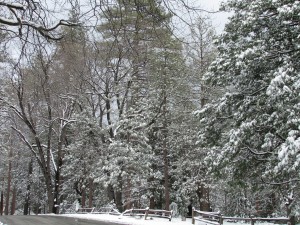
Snowy Trees The silence was so profound I could hear the snow fall. There was wildlife looking for food for their young. A mother Gray Squirrel was eating at a squirrel feeder. The bare spots on her tummy show that she is nursing young. I also saw Steller jays, robins, pine siskins, a flicker, crows, quail, goldfinches and acorn woodpeckers. There were bunny tracks in the snow.

Mother Squirrel That evening we communed by the fire in the lodge after a great meal of vegetarian vegetable soup and fresh bread. I enjoyed my cup of cocoa with peppermint Schnapps, but the caffeine made me sleep only three hours. I wasn’t alone with being tired; several other women had little or no sleep either. Saturday the sun was out and the snow began to melt, causing the streets to turn into running water.
Snow Flowers W e took a walk in the morning, ate macadamia nut pancakes, performed Tai-Chi, Zumba, aerobics, work at a barre, more walking, yoga and Pilates, then another walk into town for dinner. During dinner, it began to snow again, big, slushy wet snow that we hadn’t expected.
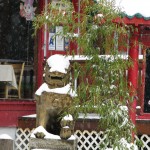
Hibernating Dragon It was dark when we finished eating, and we visited a couple of shops that stayed open for our group, then ventured through the very wet snowfall back to the lodge and warmth. It snowed all night again, to make our last morning one of magical landscapes. It was Sunday morning, the sky was blue with soft clouds, the quiet was profound and the snow sparkled as if someone had tossed around slivers of diamonds.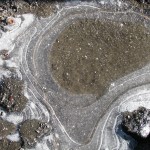
Ice A group of us took a silent walk through the snow and trees, not speaking, but pausing to perform simple yoga breathing and awakening stretches, welcoming the peace and freshness into ourselves and sending our thanks for the moment out to the universe.
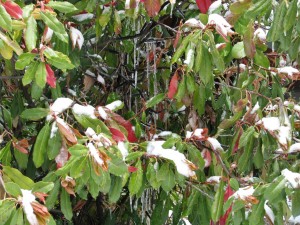
Icicles in Bush This exercise enervated me more than any other during the weekend; I only regret that not all of the women shared it with us. (After little sleep on the first night and a series of vigorous workouts through the day, along with all the energy spent shivering, several slept in.) One of the phenomenas of the morning was the rising sun catchingthe snow as it melted from the trees, highlighting the drops as if it were handfuls of glitter. I took many photos of it, trying to capture the spectacular sight, but none of them do it justice. If you look carefully at the photo, you can kind of see what I’m talking about.

Shimmering snowmelt After our wonderful breakfast (pecan maple pancakes!) we headed off down the mountain in glorious weather. I took a last explore through the town, finding a shop that made its own candles, some scented Idyllwild Cabin, and Campfire Smoke, and Citrus Champagne… and they really smelled like their names! I bought some Christmas gifts (beat the crowd! It was snowy outside after all!) and drove out of the snow to home.

- Easter Bunny Tracks
I’m posting more photos on my Facebook page if anyone is interested. The Spring Retreat turned out to be a Winter Wonderland, but I’m sure that it won’t throw the Easter Bunny off at all.
-
San Elijo Lagoon Hike
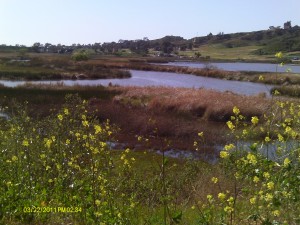
- San Elijo Lagoon
If you enjoy a hike along a flat trail with lots of nature to admire, you really should go to San Elijo Lagoon. Multiple times. That is because it has many different trails, most of which can be linked together for a long hike.
San Elijo Lagoon is protected by the San Elijo Lagoon Conservancy, the County of San Diego Parks Dept., and California Fish and Game ( http://www.sanelijo.org/welcome-san-elijo-lagoon-ecological-reserve). It is one of the largest wetlands in San Diego County, and the estuary is a wonderland for birders. The lagoon lies between Encinitas and Solana Beach, and occupies about 1,000 acres.
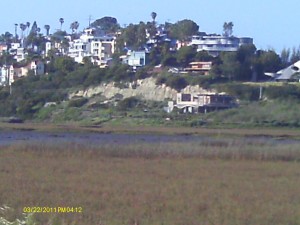
The Nature Center is run by the County and staffed by two rangers. In the photo at left it is the lowest building to the right of the cliffs. It is an fine example of a ‘green’ building, using solar, reclaimed water, a green roof and much more. Inside are very cool interactive computers and displays demonstrating how tides effect the estuary, the history of the area, and much more. Outside of the Nature Center is a boardwalk trail loop with benches and interpretive displays. During the change of tide there is a great opportunity to watch any number of seabirds fishing right next to the walkway. Watching the glorious sunset with the Coaster zooming past and cormorants fanning their wings on the telephone pole makes it easy to feel very, very happy about living in San Diego.

The Nature Center has a parking lot, and it is accessed from Manchester Ave. Visit the website for exact directions. The parking lot does have hours of closure, and this loop trail is independent from the other trails.
If you continue along Manchester you’ll see a sign for the Lagoon’s Dike Trail on the right. You have to park along Manchester Ave. Walking along the dike is one of the best ways to see dozens of seabirds, some in flocks of hundreds, very close-up. If it has been raining, you may want to check the condition of the dike because, as we found out, it can overflow.
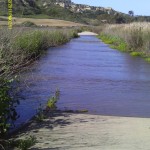
Once across you have the option of hiking West or East. If you opt for West, you eventually walk under I-5, which is an interesting experience in itself, then around through old Eucalyptus trees under the eroded cliffs overlooking the estuary. You have a choice of two trails which connect later, one takes the high road, and one takes the low road, so to speak.
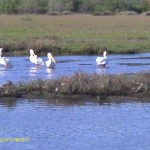
The lower one skirts the water and the higher one leads you through tall native plants. There are lots of flowers, birds, lizards, and interesting plants on either hike. At the end of the lower trail there are interpretive signs. The trail leads up to a trailhead off of North Rios Avenue, where there is street parking. You can continue West from there down to another walkway out into the wetlands for good bird viewing, and even further around the water and close to the train tracks past the water treatment plant (which is a little smelly) and out to where there are interpretive signs describing huge sewage tanks that had been at the site. That is as far as you can go, and you have to turn around and hike back.
Southeast of the Dike Trail are several miles of hiking that extend almost all the way to El Camino Real. There are several more trailheads to drive to and park.
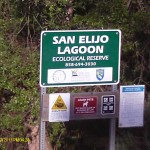
There are lots of joggers and hikers. The pathways are well maintained and I’ve rarely had to pick up any trash along the way. Along with many seabirds, songbirds and raptors you may see mule deer and find the tracks of nighttime visitors such as coyote and racoon.
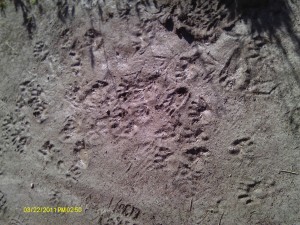
Although the hiking is along a flat area, there is a lot of it and the coastal sun is deceptively hot in that cooling breeze. Take lots of water, comfortable shoes (you can get them on shoe hero), a hat and sunscreen, and a jacket in case the famous low clouds and fog come blowing in.
This is a wonderful area for good exercise through several different plant communities with lots of good birding opportunities. You can’t do it all in one go, so plan for several trips, keeping an eye on the tide tables. Plan it around a good dinner at a coastal restaurant (such as Siamese Basil Thai restaurant in Encinitas… my favorite!) and an even beach stroll… sounds like a wonderful day to me!

